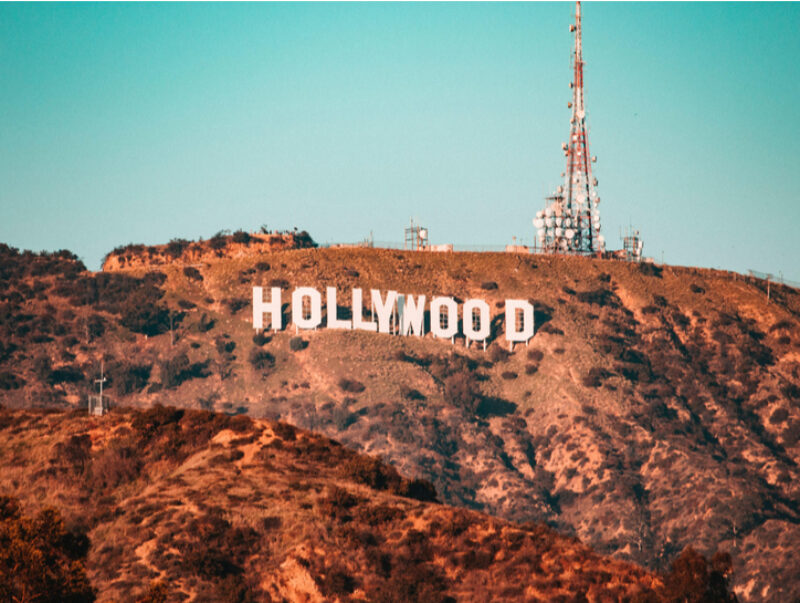The 45-foot-high letters of the famous Hollywood Sign will get a repaint later this year, a well-deserved make-up call ahead of their 100th birthday.
Located in Griffith Park in the Santa Monica Mountains, the sign – which originally spelt “Hollywoodland” – had nothing to do with the Golden Age of filmmaking. An advertisement for a local housing development, it was only intended to stay up for 18 months.
Since then, the sign has become part of modern popular culture, the area it presides over giving the world some of its most enduring big-screen moments.
Ahead of the sign’s centenary, and Casablanca’s 80th birthday, keep reading for your rundown of some classic films from, and about, this incredible era.
1. The Wizard of Oz (1939)
Hollywood’s Golden Age was dominated by the five major studios of the time, Metro-Goldwyn-Mayer (MGM), Paramount, Fox, Warner Bros., and RKO.
MGM’s 1939 film The Wizard of Oz would become a cinematic great. It would also, many years later, shine an uncomfortable spotlight on the power the major studios had at that time, especially regarding their treatment of the film’s young star, Judy Garland.
Rupert Goold’s 2019 biopic Judy stars Renée Zellweger, Rufus Sewell, and Michael Gambon, and is based on the West End and Broadway smash End of the Rainbow.
The film follows Judy Garland in her troubled later years, highlighting her struggles on the set of The Wizard of Oz through flashbacks.
The Wizard of Oz itself is based on L. Frank Baum’s The Wonderful Wizard of Oz (1900) and tells the tale of Dorothy Gale. Whisked away from her Kansas home, she must make new friends and set off on a perilous journey along the yellow brick road.
2. Citizen Kane (1941)
Citizen Kane is the debut feature by American auteur Orson Welles. Having risen to fame through his adaptation for radio of HG Wells’s The War of the Worlds, it was his work in cinema that would cement his legacy.
Citizen Kane tells the life story of media magnate Charles Foster Kane through a series of flashbacks and flashforwards. Welles co-wrote, produced, and directed the film in what would become his trademark style. He also starred in the lead role.
The film has consistently been voted as one of the best films of all time, topping the influential Sight & Sound magazine’s “Greatest film ever made” list for 50 consecutive years.
Welles continued working on film, television, and theatre for the rest of his life, completing his final projects in the mid-1980s.
Citizen Kane remains his best-remembered and most-beloved work.
The film’s legacy lives on in David Fincher’s 2020 black-and-white biopic, Mank. The film, set in and around Hollywood’s RKO and MGM studios, tells the story of Herman J Mankiewicz as he co-writes the screenplay for Citizen Kane.
3. Casablanca (1942)
Humphrey Bogart’s Rick Blaine never utters the immortal line “Play it again, Sam”.
The misquote would, though, become the name of a 1972 film by Woody Allen. Allen stars as a Casablanca-obsessed movie critic who starts dating again following a divorce.
The original film, a romantic drama set during the second world war, won an Oscar for best picture and has since been hailed a classic.
Bogart’s Rick Blaine is running a Casablanca nightclub filled with spies, Nazis, and members of the resistance when an old flame arrives.
The appearance of Ingrid Bergman’s Isla Lund causes Rick to utter the memorable line: “Of all the gin joints in all the towns in all the world, she walks into mine.”
Originally released in November 1942, the film celebrates its 80th birthday next month.
4. Sunset Boulevard (1950)
Six years before the release of Sunset Boulevard director Billy Wilder released Double Indemnity, one of Golden Age Hollywood’s finest film noirs. Based on James M. Cain’s book, the screenplay was co-written by Wilder and noir novelist Raymond Chandler.
Having achieved great success with that film, by 1950, Wilder was pre-empting the end of Hollywood’s Golden Age with the cynical black comedy Sunset Boulevard.
A poison pen letter to the film industry – and named after a major street that runs through Tinseltown – William Holden’s screenwriter meets Gloria Swanson’s former silent-era movie star. As she hires him to work on a screenplay intended to return her to stardom, Swanson’s character begins to lose touch with reality.
The film’s themes of success at all costs, delusions of grandeur, and the ability of power to corrupt caused MGM co-founder Louis B. Mayer to publicly accuse Wilder of disgracing the industry. Mayer went so far as to suggest that Wilder “should be tarred and feathered and run out of Hollywood!”
The film was nominated for 11 Academy Awards and won three.
For a more modern take on screenwriting for the big studios during Hollywood’s Golden Age, try the Coen Brothers’ Barton Fink (1991).
5. Ben-Hur (1959)
Based on an 1880 novel by Lew Wallace and directed by William Wyler, Ben-Hur’s $15 million (£11 million) budget made it the most expensive film ever made upon its release.
If a film’s worth is measured in awards success, the huge budget was money well spent. Ben-Hur swept up at the 32nd annual Academy Awards, winning 11 of the 12 Oscars it was nominated for.
The film stars Charlton Heston as Judah Ben-Hur, a rich prince who is betrayed and sold into slavery. His battle for freedom culminates in a chariot race, a fraught 9-minutes of screen time that required 7,000 extras and took nearly a year to plan.
Ben-Hur topped the US box office for six months, becoming the second highest-grossing film of all time, behind Gone with the Wind.
 Investment
Investment Trustee
Trustee

